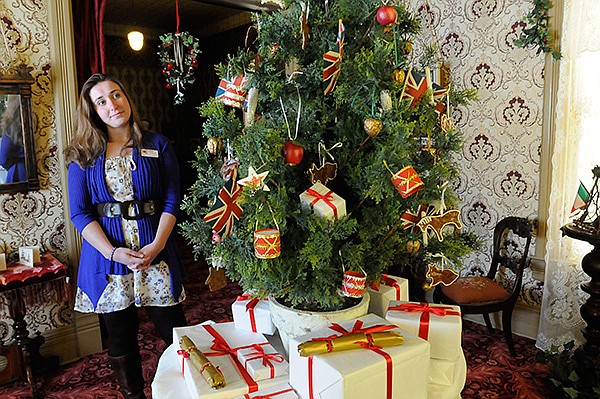It’s Christmas all over the world at the Hawkins House, with the traditions of “the American melting pot” captured in the kitchen, dining room, parlor and bedroom of the 1895 home.
The holiday transformation of the house, which is part of the Rogers Historical Museum, is a tradition, too.
“It seems that we’ve been decorating for Christmas in the Hawkins House since 1988, so about 25 years,” says Terrilyn Wendling, the museum’s assistant director. “It started with the theme ‘A Victorian Christmas,’ which they repeated for several years before landing on diff erent themes related to Christmas to highlight in the house.
“It’s our way of bringing people to the museum during the holidays,” she adds, “but also (our way) to tell the multilayered history of Christmas in small, digestible themes.”
This year’s theme is “An Old World Christmas,” and for inspiration, Wendling turned to the Europeans who fi rst emigrated to Northwest Arkansas.
“Rogers was settled primarily by people of German, French, Italian, English and Scandinavian descent,” she says. “I’m not sure when exactly each of these came, but generally they made up the bulkof Northwest Arkansas until the 1920s and ’30s, when efforts were made to grow the industries and population through advertisement eff orts.
“Then a large flux of new people came in in the 1960s with the newer industries, but again people tended to be Western European. Not until the ’70s or ’80s do you get the influx of Hispanics, Eastern European and of course now, the Middle Eastern and Asian groups are coming in.
“The house is generally set up for the turn-of-thelast century and slightly earlier,” Wendling explains. “The idea is that these are the traditions that those who settled here brought with them, but we do look at how some of those traditions changed over time and their pagan roots. For example, we have the large Christmas tree or tannebaum from the German tradition, but before they began that tradition, they originally put out a threetiered shelf with candles.”
The guided tours start in the kitchen, paying homage to the traditions of France, where a sumptuous supper, “la reveillon,” is served after Christmas Eve Mass, and a candle burns in each window throughout the night. Also on Christmas Eve, children set out their shoes to be filled with gifts by Pere Noel.
Then it’s a short hop to Italy by way of the dining room.
“The centerpiece of an Italian Christmas is the manger scene, or presepio, which is often placed on a ceppo, a pyramid of shelves full of candles and fruit,” Wendling writes in the exhibit guide. “Other images of the Madonna and Child are prominently displayed, and the house is decorated with lemon blossoms and periwinkle.”
Stepping into the front parlor, visitors will travel to the British Isles and be greeted by a traditional tabletop Christmas tree.
“The English were the first to begin the custom of hanging a mistletoe kissing ball such as the one in the doorway at Christmas time,” Wendling says. “They also gave the world the tradition of sending Christmas cards like those arranged on the table to the left of the doorway.
“The abundant use of holly is an Irish custom, as is the placing of a large candle in the front window.”
The tannenbaum, the German version of a Christmas tree, takes center stage in the back parlor.
“On one of the tables is a soup plate for each child in the house,” Wendling adds. “German children believe that on Christmas Eve the Christkindl, an angle-like heavenly messenger, comes to fill the plate with fruit and sweets and leaves larger presents on the table.”
Finally, in the bedroom, visitors will learn about Christmas in Scandinavia, where “ the holiday season is a long one, lasting into mid-January.”
The exhibit won’t stick around quite that long at the Hawkins House: Tours end Jan. 4.
Wendling says next year’s theme will be “Here Comes Santa Claus,” “where we’ll explore the ever-changing image and traditions of Santa Claus.”
Life, Pages 6 on 12/18/2013

